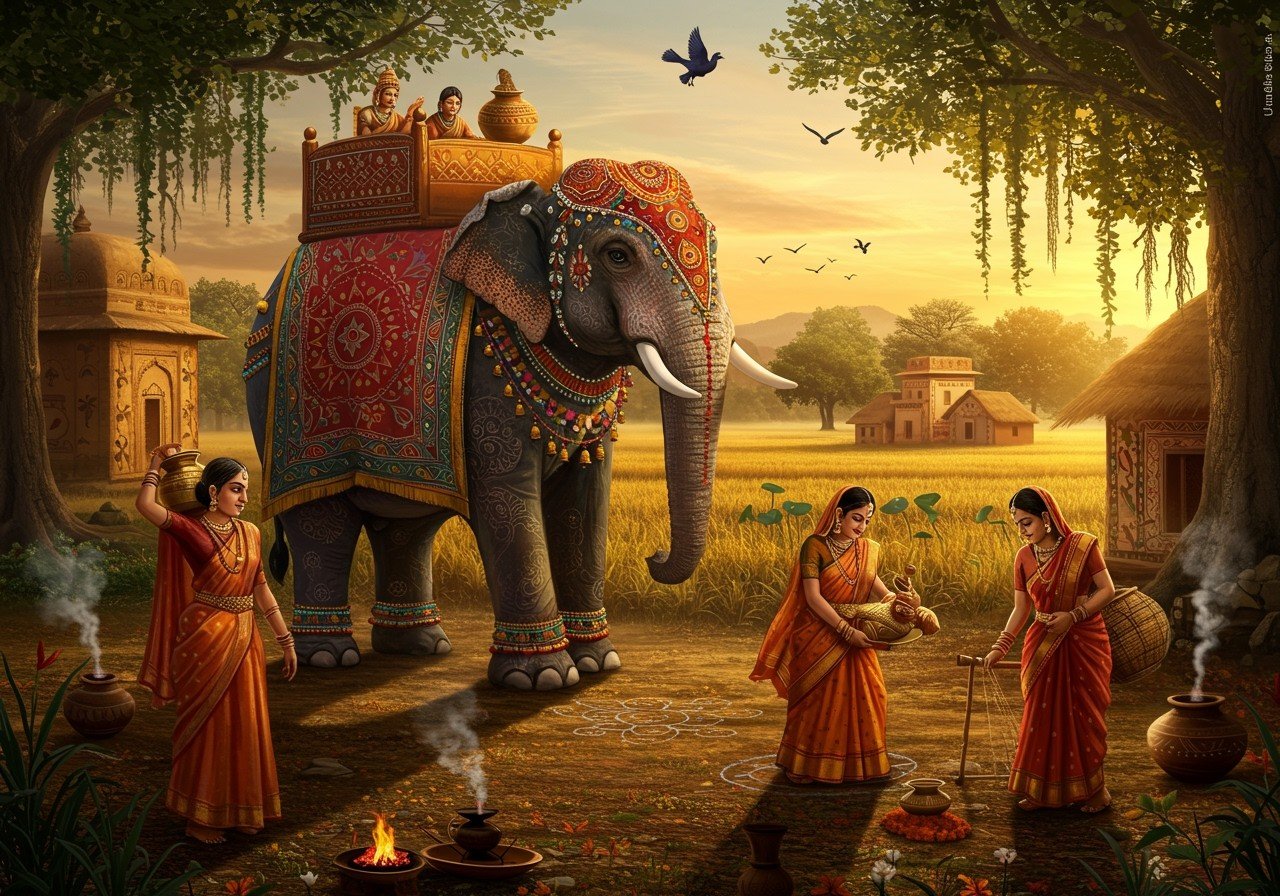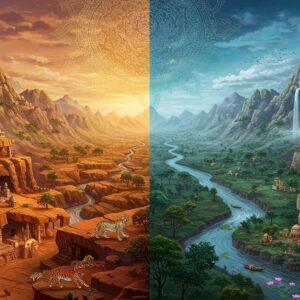
Indian paintings are a vibrant expression of the nation’s cultural identity, showcasing intricate details and a rich tapestry of themes. These artworks offer a captivating glimpse into India’s history, traditions, and spiritual beliefs, making them a treasured part of the country’s heritage. Common themes like village life, women, and elephants are frequently depicted, each carrying deep cultural and symbolic meanings. These artistic representations provide a window into the heart of India, allowing us to connect with its vibrant past and present.
Depicting Rural Harmony: Indian Village Paintings
Village life holds a central place in Indian art, with paintings often showcasing the everyday rhythms and rituals of rural communities. These artworks capture scenes of daily activities, festivals, and the serene beauty of rural landscapes. The symbolism embedded within these scenes reflects the values, traditions, and close-knit nature of these communities, often depicting themes of unity, harmony, and reliance on nature. Artists masterfully employ color and composition to evoke a sense of tranquility and simplicity, highlighting the interconnectedness of life in rural India.
- Madhubani Art: Originating in Bihar, Madhubani paintings are renowned for their vibrant colors, intricate patterns, and depictions of village life, nature, and mythology. They often feature symbolic imagery of fertility, prosperity, and community, using natural dyes and pigments. The bold lines and flat perspective create a unique visual style.
- Warli Art: Hailing from Maharashtra, Warli paintings employ a minimalist aesthetic, using simple geometric shapes to depict scenes of village activities, social life, and the natural world. Traditionally created with white pigment on a mud or clay background, Warli art emphasizes harmony and balance within the community and its environment.
These village paintings serve as a vital link to India’s past, preserving stories and heritage and connecting generations through the power of artistic expression. They offer a timeless glimpse into the heart of rural India, reminding us of the enduring strength and beauty of traditional village life.
Celebrating Feminine Grace: Indian Paintings of Women
Indian paintings often celebrate the beauty, strength, and diverse roles of women. From goddesses to everyday figures, these portrayals showcase women as symbols of grace, spirituality, resilience, and power. The depictions highlight the multifaceted nature of femininity in Indian culture.
Jewelry and attire play a significant role, signifying the status, emotions, and cultural background of the women portrayed. The artists’ careful attention to posture and facial expressions adds depth and emotion to their stories, revealing inner thoughts and feelings.
- Raja Ravi Varma: Celebrated for his realistic portrayals of women, Raja Ravi Varma’s paintings capture their essence with remarkable detail and sensitivity. His works often depict mythological figures and scenes from Indian epics, bringing these stories to life. His unique blending of European academic style with Indian subjects created a new artistic language.
- Pattachitra Art: This traditional art form from Odisha uses stylized forms and bold colors to depict women, often emphasizing their divine nature or roles in mythology. Intricate details, vibrant hues, and cloth-based canvases define Pattachitra, preserving ancient storytelling traditions.
These paintings reflect societal views of women and their evolving roles over time, serving as a visual record of changing perceptions and cultural norms. Their timeless charm continues to inspire and resonate with viewers today.
The Majestic Elephant in Indian Art
Elephants hold a revered position in Indian art, symbolizing strength, wisdom, royalty, and good fortune. Often associated with deities like Lord Ganesha, they appear in both religious and royal contexts, representing power, prosperity, and auspicious beginnings.
Artists employ vibrant colors and intricate designs to capture the grandeur and majesty of these creatures. The depictions of elephants carry rich cultural meanings, connecting viewers to India’s deep-rooted traditions and spiritual beliefs.
- Pichwai Art: This traditional Rajasthani art form often features elephants adorned with elaborate decorations, usually in the context of depicting Lord Krishna. The intricate details and vibrant colors celebrate the divine and the regal nature of elephants. Natural dyes and hand-spun cotton canvases contribute to the rich heritage of Pichwai.
- Kalamkari Art: Known for its detailed and expressive portrayals of elephants, Kalamkari art showcases these majestic creatures in natural settings and during festivals. Using natural dyes and hand-painted designs, Kalamkari captures the dynamism and grace of elephants, often narrating mythological or historical events.
Through these artistic expressions, elephants become a powerful metaphor for India’s cultural heritage, connecting viewers to the country’s rich history and spiritual depth.
Interwoven Themes and Symbolism
The themes of village life, women, and elephants often intertwine in Indian paintings, creating a rich tapestry of cultural narratives. These interconnected themes reflect the cyclical nature of life and the delicate balance between the spiritual and material worlds, highlighting the interconnectedness of all living things.
Art forms like Madhubani and Gond beautifully capture this holistic view of Indian culture. Their vibrant colors and intricate patterns reveal a deep understanding of nature, community, and the divine feminine. These art forms often symbolize fertility, prosperity, and the interconnectedness of life. They offer a unique perspective on the world, showcasing the spiritual and cultural richness of rural India.
Explore exquisite Lakshmi Mata Murti at Poojn.in
Preservation and Evolution: The Continuing Legacy of Indian Art
Preserving traditional Indian painting styles is crucial for safeguarding the country’s artistic heritage. While modernization has undoubtedly influenced these art forms, leading to new interpretations and expressions, the essence of tradition remains strong. Contemporary artists often blend age-old themes with modern perspectives, making these art forms relevant to a wider audience.
Digital platforms have played a significant role in increasing the accessibility of Indian art globally. While artists face new challenges in the digital age, they also find unprecedented opportunities to share their work with a global audience, fostering a deeper appreciation for Indian art and culture.
The continued use of traditional materials, such as natural pigments, rice flour paste, and bamboo brushes, underscores the commitment to preserving the authenticity of these art forms. This dedication to preserving traditional techniques ensures that the rich heritage of Indian painting continues to thrive while embracing the possibilities of innovation and change.
Shop Traditional Indian Art at Poojn.in
Poojn.in, India’s leading provider of cultural goods and services, offers a curated selection of authentic Indian paintings. Discover artworks that celebrate India’s rich cultural heritage and bring the essence of tradition to your home. Our collection features diverse styles and themes, including:
- Traditional Rajasthani village scene paintings capturing the essence of rural life.
- Folk art depicting rural Indian life, showcasing everyday scenes and cultural celebrations.
- Classical paintings of women in traditional attire, celebrating the grace and beauty of Indian women.
- Spiritual artwork featuring elephants and deities, connecting viewers to India’s rich religious traditions.
- Hand-painted pieces by skilled artisans, ensuring authenticity and quality craftsmanship.
Key features of our art collection:
- 100% authentic traditional artwork: We guarantee the authenticity of every piece in our collection.
- Carefully packaged for safe delivery: Ensuring your artwork arrives in pristine condition.
- Certificate of authenticity provided: Verifying the origin and artistry of your purchase.
- Multiple size options available: Finding the perfect fit for your space and preferences.
- Secure online payment: Providing a safe and convenient shopping experience.
- Pan-India shipping: Delivering art to your doorstep across India.
to explore our complete collection of Indian paintings. Each piece is carefully chosen to bring the beauty and spirituality of Indian culture into your home. Our paintings also make meaningful gifts for special occasions, conveying your appreciation for art and tradition. For bulk orders or custom requirements, please contact our customer service team through our website. Experience the convenience and authenticity of shopping for Indian art at Poojn.in, India’s largest Dashakarma bhandar.
Conclusion: A Timeless Heritage, a Vibrant Future
Indian paintings, with their vivid depictions of village life, women, and elephants, offer a profound insight into India’s rich cultural tapestry. They serve as a testament to the enduring power of tradition while embracing the dynamism of innovation. As we admire these artworks, we engage with timeless stories, evolving narratives, and the vibrant spirit of India. The vibrant colors, intricate patterns, and symbolic imagery remind us of a culture that values its past while looking towards the future with hope and creativity. In today’s digital age, the increasing accessibility of these paintings allows people worldwide to connect with the beauty and depth of Indian art. It fosters a deeper appreciation for the stories they tell and the emotions they evoke. By supporting traditional artists and exploring new interpretations, we play a vital role in keeping this rich heritage alive, ensuring that its legacy continues to inspire and captivate for generations to come.
FAQs on Indian Paintings
What are some common themes depicted in Indian village paintings?
Indian village paintings often showcase scenes of daily life, traditional attire, festivals, rural landscapes, and the harmonious relationship between humans and nature. These themes emphasize the strong community bonds, cultural values, and simplicity of rural life.
How are women typically portrayed in Indian paintings?
Women in Indian paintings are often depicted with grace, elegance, and strength. They are portrayed in various roles, including goddesses, mothers, caregivers, and figures from mythology, symbolizing beauty, nurturing qualities, resilience, and spiritual power.
Find high-quality Sindoor at Poojn.in
Why are elephants so prominent in Indian art?
Elephants hold significant cultural and religious symbolism in India, representing wisdom, strength, good fortune, and royalty. They are often associated with deities like Lord Ganesha and appear in paintings depicting religious ceremonies, royal processions, and natural settings, embodying power, prosperity, and auspiciousness.
What is the significance of color in Indian paintings?
Colors play a vital role in Indian paintings, often carrying symbolic meanings. Red can represent purity, fertility, and marriage, while blue can symbolize divinity and calmness. The use of vibrant and diverse colors enhances the storytelling, evokes emotions, and adds depth to the artwork.
How do Indian village paintings contribute to preserving tradition?
Indian village paintings depict traditional lifestyles, attire, customs, rituals, and cultural practices. By capturing these elements, they serve as a visual record of cultural heritage, passing down traditions and values to future generations and preserving the unique identity of rural communities.
Deepen your understanding of Kali Ma devotion.
Are there specific art styles commonly used in paintings of Indian women?
Yes, various art styles are employed in portraying Indian women, each with unique characteristics and regional influences. Madhubani, Rajput, Mughal, and Tanjore paintings, among others, offer distinct perspectives on the beauty, roles, and cultural significance of women in Indian society, highlighting their attire, adornments, and emotional expressions.
What is the religious symbolism of elephants in Indian paintings?
In religious contexts, elephants are often associated with Lord Ganesha, the remover of obstacles and the god of wisdom and good fortune. They are depicted as divine vehicles, symbols of spiritual strength, and participants in religious processions and festivals, signifying auspiciousness, divine power, and the removal of negativity.
How do artists capture the daily life of Indian villages in their paintings?
Artists skillfully portray the daily life of Indian villages by depicting scenes of farming, harvesting, fishing, pottery making, weaving, market scenes, festivals, community gatherings, and other everyday activities. These paintings often highlight the simplicity, interconnectedness, and cultural richness of rural life.


